Mary Talbert in France
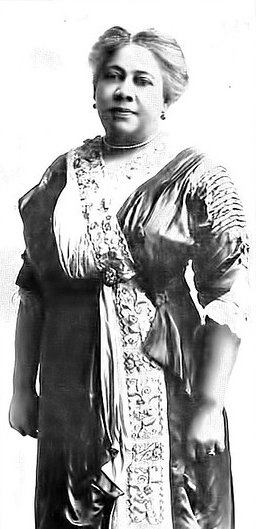
Mary B. Talbert. A headshot from this was used in her 1919 passport. Image source: public domain
Mary Burnett Talbert, a star in Buffalo's history, particularly in the Black community, came to Buffalo in 1891 when she married William Talbert, a successful Buffalo businessman. A graduate of Oberlin College, she had enjoyed a career in education as a teacher and a principal in Arkansas.
In Buffalo, she was a founder of the Phyllis Wheatley Club and worked continuously to improve the lives of Black Americans. Inevitably, her activism and oratorical skills saw her achieve state and then national prominence. She was president of the New York Empire State Federation of Colored Women, an organization of black women's clubs, from 1912-1916. And she became president of the National Association of Colored Women's Clubs in 1916, a position she held until 1921. It was this position that opened the door to her work immediately after World War I ended.
On May 20, 1919, Mary Talbert sailed for France as the last woman appointed a YMCA worker (called "secretary" by the YMCA). YMCA secretaries were assigned to canteens, called "huts" by the YMCA, where they would prepare and serve food, provide reading and writing materials, and provide cheer and a taste of home. There were very few Black women approved by the YMCA for service abroad; racism and segregation overlaid every decision among American service organizations and the military during the time abroad. Only 19 Black YMCA women were sent to France, and all of them arrived after the November, 1918, armistice. Most were assigned to the port cities, where Black labor battalions were continuing their work loading ships now returning to the States.
But there was another group of Black laborers who toiled amidst the battlefields after the war, and it is these that Mrs. Talbert served. They were the Black labor battalions tasked with the exhumation and reburial of soldiers who died in battle.
Military authorities faced a unique problem after the U.S. entered WWI in 1917, namely, how to deal with the remains of soldiers killed on the battlefield. In 1917, the Graves Registration Service was created and had to create procedures from scratch. The first problem was how to temporarily bury bodies near where they fell; fellow soldiers were understandably reluctant to take on the job. The GRS applied to authorities for the transfer of 500 white soldiers who would undertake the task. This application was refused; soldiers were needed to fight. So the GRS came back with a request for 500 men from an all-Black Pioneer division to do the job. This was immediately approved, and that is how Black soldiers from labor battalions became closely associated with the burial (and reburial) of soldiers killed on the Western Front. They were dispatched to locations were temporary burials were needed; these were immediately behind the lines and the men were always in danger from enemy artillery.
After much negotiation with the French, a number of American cemeteries were laid out. Our story, with Mary Talbert, focuses on the Meuse-Argonne Cemetery at Romagne, what would become the largest American cemetery in Europe. At Romagne, the 813th, 815th, and 816th Pioneer battations, numbering 6,000, were assigned to retrieve the bodies and dig the graves. They would exhume at least 23,000, 14,246 of whom were buried in the new American cemetery.

Back Next
Mrs. Talbert had applied for her passport in February 1919 as president of the NACWC but then revised it to list her purpose for traveling as YMCA secretary. An exception was made for her age; while the maximum age for YMCA secretaries was 40, Mrs. Talbert was 53. She arrived in France in early June. Shortly thereafter, she joined three other YMCA secretaries and traveled to the Romagne camp where the Black labor battalions were at work on the Meuse Argonne cemetery. They were sent to Romagne at the request of the white military officers there who noted that the Black laborers were restive and, they feared, about to mutiny.
The Black labor battalions had numerous justified grievances. They were provided with the poorest quality of everything: clothing, rations, dwellings; this practice had been the rule for Black labor battalions from the time they were organized in the states. While at Romagne, white soldiers told French civilians (who had been supportive of the Black men) that the Black laborers had been assigned to exhume bodies because the laborers were diseased.
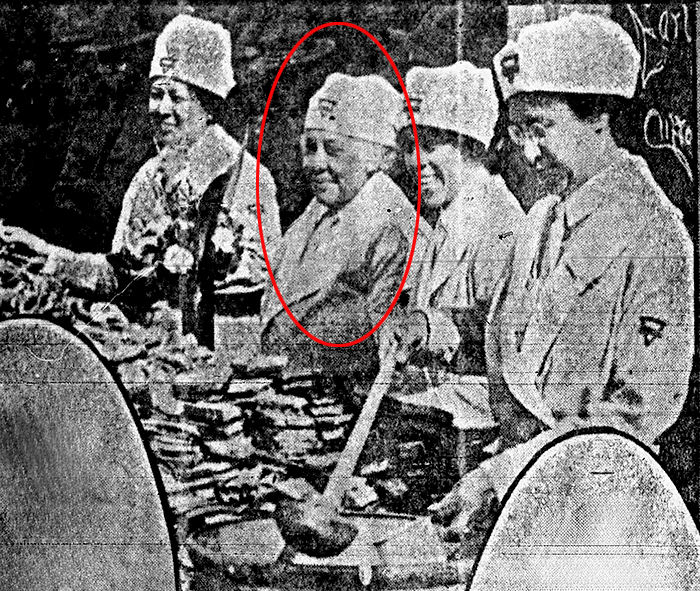
From left to right: Helen Curtis, Mary Talbert, Miss Edwards, Miss Rochon. Image source: Buffalo Express
Mrs. Talbert and her comrades established the only canteen that would serve the Black laborers. One of the authors of "Two Colored Women With The American Expeditionary Forces," Kathryn Johnson, said, “Rations were often scarce and poor at Romagne because we were so far from supplies, hence we prepared and served food for the soldiers all day long. But this was a small task compared with that of keeping the men in good spirits and reminding them again and again of the glory of the work they had in hand. Always, whether in the little corner set aside in the Y barracks as our reception room, or among the books they liked so well to read, whether by the side of the piano or over the canteen, we were trying to love them as a mother or a dear one would into a fuller knowledge and appreciation of themselves, their task and the value of forbearance.”
The YMCA secretaries may have been preaching “forbearance” because of the simmering tensions among the Black laborers. “We felt most of the time that we were living close to the edge of a smoldering crater.”
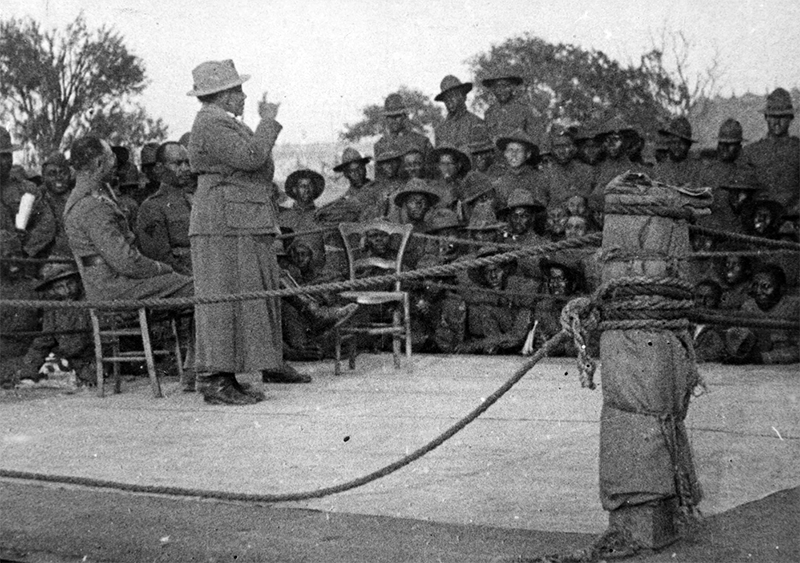
Mary Talbert speaking to Black laborers at Romagne. Image source: U. Minnesota Kautz Family YMCA Archives
While at Romagne, Mrs. Talbert mounted the camp boxing ring and spoke of Frederick Douglass and his home outside Washington, D.C. which the NACWS owned. She explained the necessity of restoring his home as “the first great race shrine.” At the end of her speech, the assembled men presented to Mrs. Talbert the $1,000 purse that was to have been awarded the winner of the boxing match.
And then a crisis occurred. Outside the the Knights of Columbus tent a sign was placed restricting access to whites only. For the black laborers, this was the last straw. The tent was burned. The white officers reacted by mounting a machine gun against potential rioting. And they immediately ordered the black women operating their YMCA canteen to leave the camp and return to Paris. Thus ended Mrs. Talbert’s service in the YMCA, barely 8 weeks after arriving in France. She traveled around France for the next several weeks, networking with the National Council of French Women, attending receptions and speaking at Aix-le-Bains, Chamberg, and Versailles.
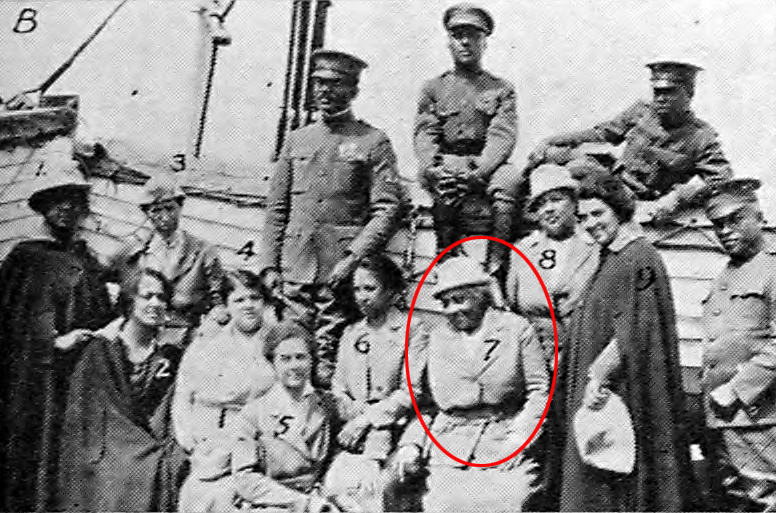
Former YMCA secretaries on their way back to the U.S.Mary Talbert circled. image source:"Two Colored Women..."
Mrs. Talbert was released from the YMCA on August 8, 1919. The next day she boarded the S.S. Noordam at Boulogne and sailed for the U.S. with the other Black women YMCA secretaries. Their smiles in the photo above belie their discrimination on board.
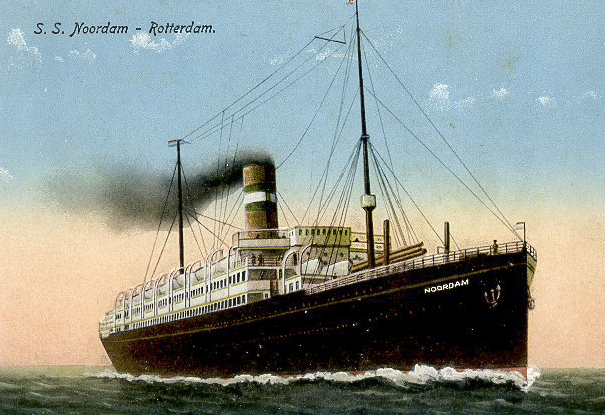
The S.S. Noordam. Image source: internet
Having been cheered and honored throughout their stay in France. the nineteen former YMCA secretaries were once again immersed in the segregationist and racist atmosphere of home. As the authors of "Two Black Women With The American Expeditionary Forces" recorded, "...all the [Black] women were placed on a floor below the white women, and the entire colored party was placed in an obscure, poorly ventilated section of the dining-room, entirely separated from the other workerss by a long table of Dutch civilians. The writer immediately protested; the reply was made that southern white workers on board the ship would be insulted if the colored workers ate in the same section of the dining-room with them and, at any rate, the colored people need not expect any such treatment as had been given them by the French."
The ship arrived in New York on August 21, 1919. Mrs. Talbert would cross the Atlantic again in 1920 as the first Black delegate to the International Council of Women. She continued her tireless efforts on behalf of Black Americans until her death in 1923 at the age of 57. This story is but a small look into her accomplished life.
Resources utilized for this story include "Two Colored Women With The American Expeditionary Forces," by Addie W. Hunton and Kathryn M. Johnson (available online); "Bodies of War: World War I and the Politics of Commemoration in American, 1919-1933," Lisa M. Bedreau; "The Unknown Soldiers: African American Troops in World War I," Arthur E. Barbeau & Florette Henri; "Into the Breach: American Women Overseas in World War I," Dorothy and Carl J. Schneider; various newspaper articles..